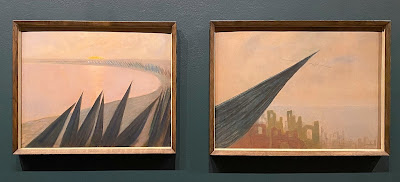M. K. Čiurlionis, My Road I-III, 1907
Dulwich Picture Gallery has frequently provided material for this blog - see my earlier posts on Adam Elsheimer (2006), Paul Nash (2010), Salvator Rosa (2010), Tom Thomson (2011), James McNeill Whistler (2013), Emily Carr (2015), Eric Ravilious (2015), Adriaen van der Velde (2016), Tove Jansson (2018), Edward Bawden (2018) and Harald Sohlberg (2019). Yesterday we went to see their new show devoted to M. K. Čiurlionis, the Lithuanian artist-composer whose work I described here ten years ago. I was looking forward to seeing Fuga (1908), the striking semi-abstract painting of trees resembling a kind of graphic score, but it isn't included. However, the other works I mentioned are on show, including Creation of the World, which takes up a whole wall.
Čiurlionis produced all his art in six years and his earliest work includes symbolist landscapes like Serenity (1904/5), a mountain that resembles a giant figure emerging from the sea. Influences include Arnold Böcklin, Whistler and Japanese prints (including Hokusai's wave), Lithuanian folklore, theosophy, the Indian Vedas, Ruskin and the Young Poland movement. Although his mountains, cities and forests have a dream-like quality, the exhibition does include one relatively conventional specific landscape - the triptych Raigardas (1907). Kathleen Soriano describes this in the catalogue: 'the higher foreground is painted at the bottom left and right of the far panels so that the viewer falls into the valley laid out between them, the silvery line of the Kulbinyčia river streaking across it. The actual valley is very close to Druskininkai and was a favourite walking location for Čiurlionis.' (Google doesn't recognise "Kulbinyčia", but Druskininkai is a spa town in the south of Lithuania where Jacques Lipchitz also grew up - he remembered as a boy seeing Čiurlionis "passing like a shadow always in deep thoughts").
M. K. Čiurlionis, Sorrow I-II, 1906/7


No comments:
Post a Comment